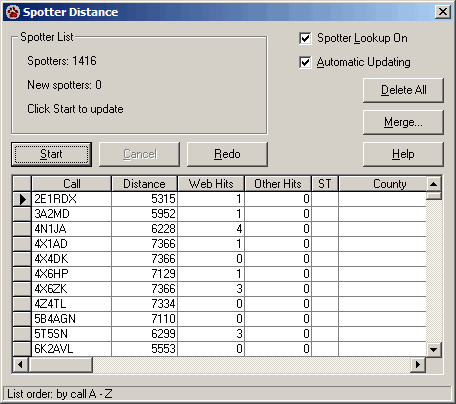It is often helpful to know the location of spotters when using the DX Spot Manager. A spot for an entity you need may have originated thousands of miles from your location, in which case you probably won't hear the DX, much less work him. Determining the distance from you to the spotter is complicated for US calls, where a simple (and fast) prefix lookup may be far from correct.
CommCat maintains a database of spotters to provide fast lookups for distance. This database is filled as spots arrive. The list is updated automatically when you choose to do so using the Spotter Distance window.

DX Spot Manager
CommCat uses the computed distance in the DX Spot Manager window. The distances are displayed in the Spotter Dist column and used in any Rules you have created with spotter distance as a condition. The distances are not used when the Spotter Lookup On check box is not checked. A distance of 0 is shown in the DX Spot Manager Spotter Dist column and the distance is ignored in rules. Turning off the spotter distance function can improve the performance of the DX Spot Manager, especially when a large number of spots is being received.
Normally the distances are computed automatically as spots arrive. If you find that lookup is too slow (because of Internet congestion, a slow connection, or you are using a CD-ROM for lookup), uncheck the Automatic Updating option. Once you start to see question marks as the first character in the From calls in the DX Spot Manager, you will know the spotter distance list needs manual updating.
If you are not using a spotter distance Condition for a Rule in the DX Spot Manager, or you don't care about filling the Spotter Dist column, uncheck both options. CommCat will continue to fill the spotter distance list with spotter calls even though you aren't using the distance information.
Window Information
The total number of spotter calls is shown at the top of the window. The number of new calls since the database was last updated is shown next. The list is updated from the sources you have chosen for call book data. The distance, state and county are added. Note that the state and county are only provided for US calls, and only when found in the call book.
CommCat uses the latitude and longitude provided by the call book to compute the distance of the spotter from your location. If the latitude and longitude are not found (as is the case for most DX calls), the distance is computed from the center of the location determined from the prefix.
Click any header to set the order of the list to the contents of that column. The current order is shown at the bottom of the window in the status panel.

You can change the contents of any field by typing new data. For example, if you know the county for a spotter, you can enter that information. The state and county are not presently used by CommCat.
The Web Hits count shows how many spots that spotter has submitted. The Other column collects the number of spots from a Telnet site or Packet radio cluster.
Delete all spotter records from the database by clicking Delete. You will be asked to confirm that you want to remove all data from the list.
Merging Data
If you receive a spotter distance database from another CommCat user, you can merge the list with your own through the Merge function. Duplicate spotter calls are ignored and any new spotter calls are added to your list without any additional data. When you update the database, this missing information is added with the values for your location.